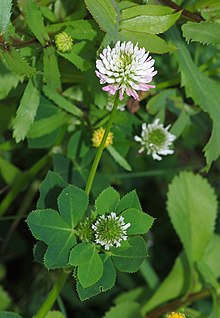Lupinaster
| Clover | |
|---|---|
 |
|
| Trifolium sp. (clover) | |
| Scientific classification | |
| Kingdom: | Plantae |
| Clade: | Angiosperms |
| Clade: | Eudicots |
| Clade: | Rosids |
| Order: | Fabales |
| Family: | Fabaceae |
| Tribe: | Trifolieae |
| Genus: |
Trifolium L. |
| Subgenera and sections | |
|
subg. Chronosemium
|
|
| Synonyms | |
|
Amoria C. Presl |
|
subg. Chronosemium
subg. Trifolium
Amoria C. Presl
Bobrovia A. P. Khokhr.
Chrysaspis Desv.
Lupinaster Fabr.
Ursia Vassilcz.
Xerosphaera Soják
Clover or trefoil are common names for plants of the genus Trifolium (Latin, tres "three" + folium "leaf"), consisting of about 300 species of plants in the leguminous pea family Fabaceae. A group of clovers is called a cluff. The genus has a cosmopolitan distribution; the highest diversity is found in the temperate Northern Hemisphere, but many species also occur in South America and Africa, including at high altitudes on mountains in the tropics. They are small annual, biennial, or short-lived perennial herbaceous plants. Clover can be evergreen. The leaves are trifoliate (rarely quatrefoiled (Four-leaf clover), cinquefoil, or septfoil), with stipules adnate to the leaf-stalk, and heads or dense spikes of small red, purple, white, or yellow flowers; the small, few-seeded pods are enclosed in the calyx. Other closely related genera often called clovers include Melilotus (sweet clover) and Medicago (alfalfa or Calvary clover).
...
Wikipedia
